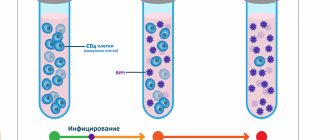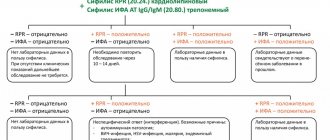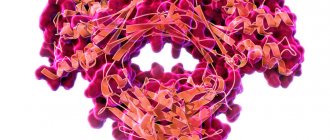Scientific editor: M. Merkusheva, PSPbSMU named after. acad. Pavlova, medical practice. March, 2021
Synonyms: PSA total, prostate-specific antigen total, Prostate-specific antigen total, PSA total.
Prostate specific antigen (PSA) is secreted by the epithelial tissues of the prostate gland. Its purpose is to naturally liquefy sperm. Therefore, normally, PSA is always present in the blood of a healthy man, but its concentration should not go beyond the established normal values. Otherwise, we can talk about the development of pathological changes in the structure and functioning of the prostate.
A test for total PSA in plasma is the most reliable and indicative in the diagnosis of benign and malignant prostate diseases and other pathological changes (inflammatory processes, infection, proliferation of pathogens, etc.). The main purpose of the study is to diagnose oncology.
General information
Prostate specific antigen is a glycated protein, a small part of which, after production by the prostate gland, is released into the bloodstream, where it circulates in 2 states - free and bound. The combination of both of these fractions is the total PSA. Their ratio is approximately 9:1. With prostate carcinoma (cancer), the level of the bound form in the blood increases, which leads to a decrease in the ratio between free and total PSA.
An increase in the level of antigen in plasma is observed in the presence of benign or malignant diseases, inflammatory and infectious processes, mechanical and thermal injuries, as well as after certain therapeutic and diagnostic procedures. A temporary release of the component is caused by ejaculation, after which its level stabilizes again after 2 days.
With age, the concentration of total PSA increases, and the percentage of the free fraction, on the contrary, decreases. A PSA test is recommended annually for men over 50 years of age (age risk group). Early screening (before 40 years of age) is indicated for patients with a burdened medical history (malignant processes in first-line relatives).
Interpretation of test results is always carried out simultaneously with other diagnostic studies: analysis of biological fluids, rectal palpation of the prostate, MRI, biopsy, ultrasound, radiography, etc.
PSA is able to inhibit the migration, proliferation and invasion of endothelial cells in the tumor and, accordingly, slow down its growth. This function may partly explain the naturally slow progression of prostate cancer.
Indicators that are determined
To assess the state of men's health, diagnostics are prescribed, including tests for the level of:
- General PSA;
- free PSA;
- percentage of free to total;
- 2-pro-PSA;
- Prostate Health Index - PHI.
The study is prescribed as a preventive measure for patients with a history of inflammatory and sexually transmitted pathologies. A comprehensive study allows you to diagnose prostate cancer or prostate adenoma at different stages.
Indications
The main purpose of determining total PSA in plasma is screening for prostate cancer (PCa), including as an additional marker based on the results of a rectal examination.
The study is also carried out to determine the stage of the cancer process, the likelihood of relapse or remission, metastasis, general prognosis, which is important in the first 6-18 months of treatment, and making a decision on whether to perform a prostate biopsy. The test allows you to monitor the effectiveness of the chosen treatment regimen (chemo-, drug or radiotherapy, hormone replacement therapy, physical therapy, surgery, etc.).
In what cases is analysis prescribed:
- Suspicion of benign or malignant processes, inflammation of the prostate, structural changes in its tissues;
- Age over 50 years (mandatory screening);
- Age over 40 years (if there are close relatives with pelvic cancer);
- Prostatic hyperplasia;
- The patient complains of difficult, painful and frequent urination;
- An increase in the size, consistency and structure of the prostate gland according to rectal examination or ultrasound.
The interpretation of the analysis results is carried out by an oncologist, surgeon, urologist, and therapist.
Important Notes
- The need to prescribe this test and the frequency of its implementation should be determined by the attending urologist.
- An increase in PSA in men is not an absolute sign of prostate cancer. The diagnosis can be confirmed or excluded only by the results of a prostate biopsy. Only 30% of patients with elevated PSA levels are diagnosed with prostate cancer.
- If an elevated total PSA level is detected, some doctors recommend repeating the test 6 weeks to 3 months after the first test and then deciding whether to perform a biopsy of the gland.
- Determining the PSA level is not recommended 24-48 hours after cystoscopy or ejaculation; within 7 days after a digital examination of the prostate, ultrasound of the prostate gland and other urological procedures; earlier than 6 weeks after prostate biopsy; earlier than 8 weeks after treatment of prostatitis.
Normal total PSA values
Important! Standards may vary depending on the reagents and equipment used in each particular laboratory.
That is why, when interpreting the results, it is necessary to use the standards adopted in the laboratory where the analysis was carried out. You also need to pay attention to the units of measurement. For a long time it was believed that total PSA should be in the range from 0 to 4 ng/ml. But according to medical statistics of recent decades, a malignant process can begin and progress at lower PSA levels (up to 2.5 ng/ml).
The current normal values for the total PSA test are presented in the table:
| Age, years | Total PSA norm, ng/ml |
| 40-49 | 0-2.5 |
| 50-59 | 0-3.5 |
| 60-69 | 0-4.5 |
| 70-79 | 0-6.5 |
A general PSA test is always combined with the determination of its free form. The latter is distinguished by the fact that it does not bind to other proteins and circulates in its original form (as it was produced by prostate epithelial cells).
As a rule, all circulating forms of PSA are determined in one analysis sample, after which their mathematical ratio is established as a percentage. This information is especially necessary in a situation where total PSA reaches 10 ng/ml, which may be due to an increased risk of severe inflammatory processes in the prostate and the appearance of malignant neoplasms. When the ratio of free to total PSA is more than 25%, the oncologist diagnoses non-malignant pathologies, while a ratio of less than 15% is an additional marker for determining cancer.
To assess pathological risks, namely, when the PSA threshold of 4 ng/ml is exceeded, the ratio (index) of the required indicators is calculated using the formula:
free PSA / total PSA * 100%
A result of more than 25% indicates a benign process or a favorable prognosis for various inflammatory diseases, structural changes in the prostate, etc. Values up to 10% indicate a high risk of developing oncology.
Important! The interpretation of the results is always carried out comprehensively. It is impossible to make an accurate diagnosis based on only one analysis.
general information
Prostate specific antigen (PSA) is a substance produced by prostate cells and is one of the most sensitive and specific tumor markers. A PSA blood test is used to diagnose prostate cancer, in which the total PSA level is significantly elevated. In addition, a slight increase in PSA is often observed with prostate adenoma and prostatitis, and to clarify the diagnosis in this case, it is necessary to determine not only total PSA, but also its free fraction (free PSA) and the PSAfree ratio. PSAtot. With an oncological process, this figure is less than 15%, with a benign disease – more than 15%.
You should know that a preventive examination of a PSA blood test for men over 50 years of age is currently considered mandatory for the purpose of early detection of prostate diseases.
Prostate-specific antigen (PSA) is a glycoprotein, an enzyme related to serine proteases. This is one of the products of prostate synthesis. is a laboratory marker of the condition of prostate tissue.
The prostate gland consists of muscle tissue and a large number (about 50) of small glands. Muscle tissue is designed to move the fluid that the prostate produces into the internal ducts towards the lumen of the urethra. In addition, intense contractions of the prostate muscles ensure the process of ejaculation during sexual intercourse. The prostate glands produce prostate secretion, which has several functions:
- is part of the seminal fluid,
- serves as an important component of the nutrient medium for sperm.
This is a complex composition of biologically active substances that ensure the vital activity of male germ cells. A small part of the secretion enters the blood and performs a complex hormonal function - ensures the normal functioning of the testicles, bladder function, regulates sexual desire, affects blood circulation, nervous processes and mental state.
One of the components of prostate secretion is PSA. According to its chemical structure, it is a glycoprotein - a combination of protein and carbohydrates; according to its biochemical properties, it is an enzyme that performs the function of splitting large protein molecules into smaller fragments. Thanks to this ability, it dilutes the seminal fluid. Along with that part of the prostate secretion that enters the systemic bloodstream, a small portion of the prostate-specific antigen produced by the prostate also penetrates there. The function of prostate-specific antigen in the body is unknown, but in laboratory diagnostics it is used to identify prostate diseases. Some of its fractions have antigenic properties, which makes it possible to identify them using immunochemical laboratory methods. The combination of these properties determined the name for this substance as “prostate-specific antigen.”
The half-life is 4 days. In blood serum, prostate-specific antigen is contained in two forms - free and associated with various antiproteases. The free form (f-PSA) content is about 10% of the total PSA. The content of total PSA normally increases with age, however, it should not exceed 4 ng/ml. Any mechanical irritation of the gland can lead to a significant increase in serum PSA concentration.
This test is highly specific for prostate tissue, but not for prostate tumors. However, as the total mass of tumor cells increases, their share in the production of prostate-specific antigen increases, having an increasing impact on the results of laboratory analysis.
The sensitivity of the PSA indicator increases significantly with simultaneous analysis of the total and free fractions of this substance in the blood and determining the ratio of the results obtained. The proportion of free PSA in the blood serum in prostate cancer is significantly lower than its level in any benign process. Due to this, a more accurate distinction between benign and malignant prostate diseases is possible with a minimal increase in total PSA.
Measuring free PSA and determining the free PSA/total PSA ratio is especially important in the case of small increases in total PSA, ranging from 4.0 to 10.0 ng/mL, at concentrations close to the upper limit of reference values.
A PSA value above 30 ng/ml usually indicates the presence of a malignant neoplasm. In patients with advanced prostate cancer and metastases, concentrations of 1000 ng/ml and higher were noted.
When monitoring treatment, it is more appropriate to compare PSA concentrations with previous serum concentration readings for a given patient rather than with reference values.
Total PSA is elevated
The probability of detecting oncology, depending on the excess of the norm:
- up to 10 ng/ml - suspicion of prostate cancer;
- 10-20 ng/ml - high risk of prostate cancer;
- 20-50 ng/ml - risk of disseminated prostate cancer;
- 50-100 ng/ml - high risk of metastases to lymph nodes and distant organs;
- more than 100 ng/ml - always metastatic prostate cancer.
Other conditions in which total PSA levels increase:
- Ischemia or infarction of the prostate;
- Hyperplasia of prostate tissue, changes in its structure or volume;
- Diseases of the genitourinary organs;
- Prostatitis in acute or chronic form;
- Benign neoplasms (cysts, adenomas, polyps, etc.);
- Cancer processes (80%).
Why is there an erroneous result?
False-positive test results can be caused by the following factors:
- recent manipulations on the prostate gland (massaging, rectal examination and palpation, transrectal ultrasound, biopsy, etc.);
- cystoscopy, bladder catheterization;
- urinary tract infection;
- intense physical activity (biking, horse riding);
- sexual intercourse and ejaculation;
- taking certain medications (allopurinol, finasteride, cyclophosphamide, methotrexate, androgen antagonists).
A PSA test is prescribed no earlier than a week after these factors have been eliminated.
Preliminary preparation
When answering the question, PSA analysis, what is it, you should know the regulations for its implementation. For the test, venous blood is taken. There are two types of tests: total and free antigen. The first is standard and is prescribed more often, the second is used to clarify the diagnosis.
The analysis requires preliminary preparation. To exclude a false positive result, you must follow the following recommendations from doctors:
- blood is donated no earlier than two weeks after medical manipulations in the genitourinary system and pelvic area;
- before the procedure, avoid ejaculation for 3 days;
- you must stop riding a bicycle or horse three days before the procedure;
- Blood sampling is carried out on an empty stomach.
Lowering values
A reduced level of a specific antigen does not indicate a deviation, but a minimal level of risk of developing malignant neoplasms. When examined over time, a decrease in total PSA less than 2 ng/ml indicates the effectiveness of treatment measures and a favorable prognosis.
In obese men, total PSA levels may be reduced due to an increase in the estradiol to testosterone ratio and hemodilution (a decrease in the number of red blood cells in the plasma associated with an increase in total plasma volume).
What to do if the indicators are elevated?
Many men are concerned about what a higher than normal PSA means. It is important to remember that a large amount of antigen does not necessarily indicate an oncological process in the body. The analysis is a stage of complex diagnostics, and its results must be interpreted by a doctor.
In addition to prostate cancer, an increase in PSA levels is caused by:
- inflammation of the male gland;
- infarction or ischemia of the prostate;
- impotence;
- urinary tract infection;
- urinary retention;
- ejaculation on the eve of the study;
- adenoma (benign hyperplasia of the gland);
- violation of the rules for preparing for analysis.
Reasons for raising a dog's level
An elevated PSA level indicates dysfunctional processes occurring in the prostate, most often of an oncological nature. But there are other reasons why the number of dogs increases:
- Action of infections. The protective functions of the tissues are disrupted, and the dog gets into the blood vessels.
- Male prostate hyperplasia, which is benign in nature. This occurs due to the pressure of the enlarged prostate tissue on healthy areas of this organ and the level of protein release in the blood becomes significantly greater.
- Exhaustive (in terms of time and intensity) physical loads.
- Interventions in the urological sphere of the male body - biopsy analysis, catheter installation.
- Palpatic examination or massaging of the prostate.
- Side effects of some drugs containing hormones.
By taking a blood test, you can determine whether the dog is normal, but the influence of the factors listed above should also be taken into account.
Other methods for diagnosing prostate cancer
When the level is several times higher than normal, then additional measurement of its level is no longer necessary, and other methods of detailed cancer diagnosis are prescribed:
Palpation
One of the oldest methods for diagnosing prostate cancer. Palpation of the prostate gland through the rectum (rectal) allows the doctor to determine by touch the presence of even a small tumor (about 0.2 ml). However, it is not always possible to palpate the tumor, depending on its location. If a tumor is detected, the person being diagnosed must be sent for further research, since it is necessary to determine whether the tumor is an adenoma or prostate cancer. For this, a biopsy is prescribed.
Ultrasound – ultrasound examination
One of the most accessible diagnostic methods for prostate cancer, however, it is not reliable. Changed prostate cells (tumor) have different echogenic properties (otherwise they reflect ultrasound, i.e. they have a different density).
Based on ultrasound scanning, the ultrasound machine should build a visual picture of the prostate tumor; however, the areas of the prostate affected by cancer are not always hypoechoic. Therefore, ultrasound is only an additional method.
Histoscanning
This is a relatively new ultrasound method that allows you to not only see on the screen the contours of the altered prostate gland and the dark spot of the tumor in it, but also the clear contours of the tumor, even at the earliest stages. It also allows you to build, based on the data obtained, a 3D model of the tumor. Histoscanning can only be carried out with a special device - histoscan.
The operating principle of this prostate diagnostic is based on the fact that cancer changes the cells of the prostate so much that they reflect ultrasound waves differently, unlike normal ones, i.e. have different acoustic characteristics. Histoscan images can be used as a detailed map for targeted biopsy.
Prostate biopsy
The prostate biopsy method allows you to obtain tissue from the prostate tumor itself to examine it in the laboratory. By studying a biopsy (obtained prostate tissue), one can make a conclusion about the nature of the tumor, the type of cancer, the stage and grade of prostate carcinoma.
Regardless of what diagnostic results you come with for treatment of prostate cancer, before surgery at the clinic you will be prescribed a biopsy to confirm or clarify the diagnosis. There have been cases when prostate cancer was not confirmed, but another disease was discovered that did not require prostatectomy.
Choline PET/CT
The radiopharmaceutical choline, being a contrast agent, accumulates precisely in malignant cells, which make up the cancerous tumor and metastases. Therefore, when diagnosing prostate cancer, especially advanced stages, PET/CT with choline is especially useful: choline accumulating in cancer cells illuminates the entire tumor and metastases.
During the diagnostic process, the image is displayed on a PET/CT monitor (positron emission tomograph, with a computed tomography function).
PSMA-PET/CT
One of the newest methods for diagnosing prostate cancer. A specific protein, PSMA (prostate-specific membrane antigen), is formed on the surface of the prostate. Using the ability of ligand molecules to attach specifically to this protein, a diagnostic method has emerged: ligands are mixed with the low-radioactive substance gallium-68.
When the ligand molecules enter the body of a prostate cancer patient, they “stick” only to prostate cancer cells, and gallium-68 mixed with them serves as a marker, as it “glows” on the PET-CT monitor. The image of the tumor and metastasis is processed in 3D mode. The method is similar in diagnostic function to the PET-CT method with choline, but significantly exceeds it in accuracy.
MRI
The magnetic resonance imaging method is used to diagnose advanced prostate cancer with metastases. MRI of the pelvis allows the doctor to see metastatic foci (spread of the tumor to other organs) with great accuracy and in different planes and diagnose the stage of the oncological process.
In each specific case, with an increase in PSA, there is a suspicion of prostate cancer, so it is necessary to immediately contact a urologist to decide on further diagnosis or prevention of prostate cancer. This is the opinion of urologist-oncologists in Germany.






